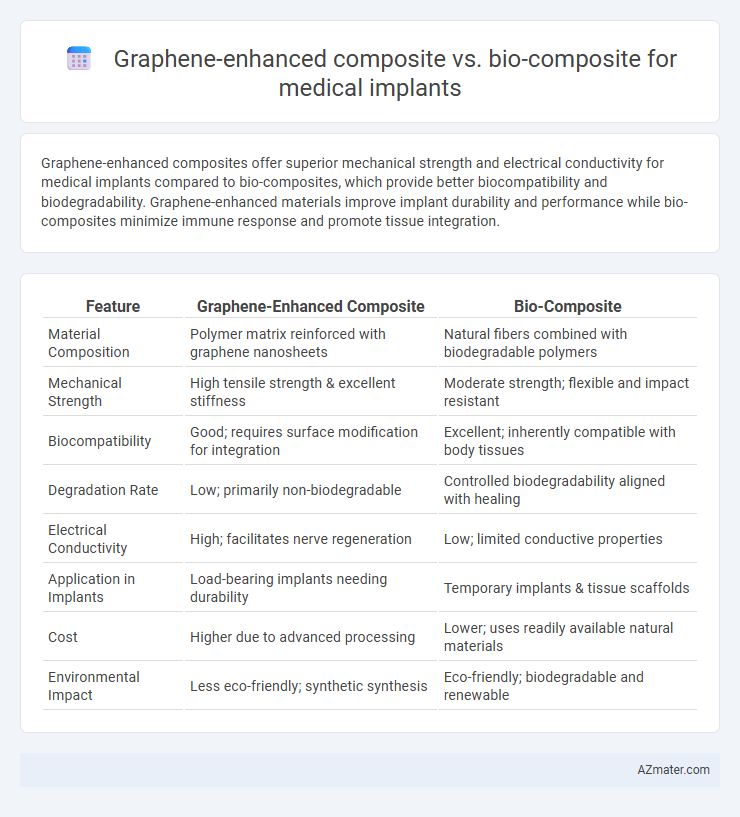Graphene-enhanced composites offer superior mechanical strength and electrical conductivity for medical implants compared to bio-composites, which provide better biocompatibility and biodegradability. Graphene-enhanced materials improve implant durability and performance while bio-composites minimize immune response and promote tissue integration.
Table of Comparison
| Feature | Graphene-Enhanced Composite | Bio-Composite |
|---|---|---|
| Material Composition | Polymer matrix reinforced with graphene nanosheets | Natural fibers combined with biodegradable polymers |
| Mechanical Strength | High tensile strength & excellent stiffness | Moderate strength; flexible and impact resistant |
| Biocompatibility | Good; requires surface modification for integration | Excellent; inherently compatible with body tissues |
| Degradation Rate | Low; primarily non-biodegradable | Controlled biodegradability aligned with healing |
| Electrical Conductivity | High; facilitates nerve regeneration | Low; limited conductive properties |
| Application in Implants | Load-bearing implants needing durability | Temporary implants & tissue scaffolds |
| Cost | Higher due to advanced processing | Lower; uses readily available natural materials |
| Environmental Impact | Less eco-friendly; synthetic synthesis | Eco-friendly; biodegradable and renewable |
Introduction to Advanced Composite Materials in Medical Implants
Graphene-enhanced composites in medical implants offer exceptional mechanical strength, electrical conductivity, and biocompatibility, making them ideal for applications requiring durability and functionality. Bio-composites, derived from natural fibers and biodegradable polymers, provide enhanced biocompatibility and reduced environmental impact while promoting tissue integration. Advanced composite materials revolutionize medical implants by combining synthetic and natural components to optimize performance, longevity, and patient outcomes.
Graphene-Enhanced Composites: Properties and Advantages
Graphene-enhanced composites exhibit exceptional mechanical strength, biocompatibility, and electrical conductivity, making them ideal for medical implants requiring durability and biointegration. Their nanoscale graphene layers improve wear resistance and promote cell adhesion, reducing inflammation and enhancing tissue regeneration compared to conventional composites. These properties enable the development of lightweight, high-performance implants with improved longevity and reduced risk of implant failure.
Bio-Composites: Composition, Sources, and Suitability
Bio-composites for medical implants are primarily composed of natural fibers such as collagen, chitosan, and cellulose combined with biodegradable polymers like polylactic acid (PLA) or polycaprolactone (PCL), offering excellent biocompatibility and biodegradability. Sources of these materials include renewable biological origins such as plant fibers, marine organisms, and animal by-products, making them sustainable and environmentally friendly. Their suitability for medical implants lies in their ability to promote cell adhesion, reduce inflammatory responses, and gradually degrade in the body, which supports tissue regeneration and reduces long-term complications.
Mechanical Strength Comparison: Graphene vs Bio-Composites
Graphene-enhanced composites exhibit significantly higher mechanical strength compared to bio-composites used in medical implants, with tensile strengths often exceeding 500 MPa due to graphene's exceptional stiffness and load transfer capabilities. Bio-composites, composed of natural fibers and biodegradable polymers, typically show tensile strengths ranging from 50 to 150 MPa, which limits their use in high-load-bearing implants. The superior Young's modulus of graphene (up to 1 TPa) enables enhanced durability and resistance to deformation, making graphene-enhanced composites more suitable for applications demanding robust mechanical performance.
Biocompatibility and Bioactivity in Implant Applications
Graphene-enhanced composites demonstrate superior mechanical strength and electrical conductivity, promoting enhanced cellular interactions and accelerated tissue regeneration in medical implants. Bio-composites, derived from natural polymers and bioactive ceramics, exhibit excellent biocompatibility and inherent bioactivity, facilitating improved osseointegration and reduced inflammatory response. Comparative studies reveal graphene's potential to enhance stem cell differentiation, while bio-composites offer biodegradability and mimic natural extracellular matrix properties, critical for long-term implant success.
Longevity and Degradation Profiles in Clinical Use
Graphene-enhanced composites exhibit superior longevity in medical implants due to their exceptional mechanical strength and resistance to biodegradation, offering prolonged structural integrity compared to bio-composites. Bio-composites, derived from natural polymers and biodegradable materials, demonstrate predictable degradation profiles conducive to temporary implantation but face limitations in durability under long-term physiological conditions. Clinical studies reveal that graphene composites maintain functional performance over extended periods, reducing the risk of implant failure and the need for revision surgeries, whereas bio-composites are optimized for applications requiring gradual resorption and tissue regeneration.
Antibacterial and Antimicrobial Performance
Graphene-enhanced composites demonstrate superior antibacterial and antimicrobial properties due to graphene's high surface area and ability to disrupt microbial cell membranes. Bio-composites, often derived from natural polymers like chitosan or cellulose, offer biocompatibility and biodegradability but typically exhibit moderate antimicrobial effectiveness compared to graphene composites. For medical implants, graphene's capacity to inhibit bacterial colonization presents a promising solution to reduce infection risks and improve implant longevity.
Manufacturing Processes and Scalability for Implants
Graphene-enhanced composites for medical implants utilize advanced manufacturing processes such as chemical vapor deposition and electrophoretic deposition, offering high precision and enhanced mechanical properties but facing scalability challenges due to complex synthesis and cost. Bio-composites, derived from natural polymers combined with bioactive fillers, benefit from simpler, more scalable manufacturing techniques like solvent casting and electrospinning, enabling cost-effective mass production while maintaining biocompatibility. Scalability of graphene composites remains limited by material uniformity and integration complexity, whereas bio-composites leverage established biomedical fabrication infrastructure for broader clinical implementation.
Regulatory Considerations and Clinical Trials
Graphene-enhanced composites for medical implants face stringent regulatory scrutiny due to their novel nanomaterial properties, necessitating comprehensive biocompatibility and toxicity assessments in preclinical studies. Bio-composites often benefit from established regulatory pathways, leveraging their natural polymer components, but still require rigorous clinical trials to demonstrate safety and efficacy in vivo. Both materials demand robust clinical evidence to satisfy FDA or EMA guidelines, with graphene composites particularly challenged by concerns over long-term stability and potential cytotoxicity in human tissues.
Future Prospects and Challenges in Implant Material Innovation
Graphene-enhanced composites offer exceptional mechanical strength, electrical conductivity, and biocompatibility, positioning them as promising materials for next-generation medical implants with improved durability and functionality. Bio-composites, derived from natural polymers and bioactive molecules, provide enhanced biodegradability and reduced inflammatory responses, making them ideal for temporary or resorbable implants. Future challenges include optimizing the integration of graphene to minimize toxicity, and improving the structural stability and controlled degradation rates of bio-composites to meet long-term implant performance requirements.

Infographic: Graphene-enhanced composite vs Bio-composite for Medical implant
 azmater.com
azmater.com